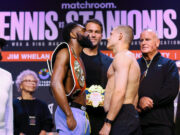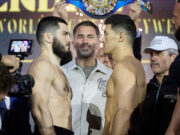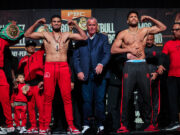CORPUS CHRISTI, TEX. – All’s clear on the bay. While most boxing writers dined together and canvassed Yankee Stadium in the Bronx this weekend, I was in the heavy, salty air of South Texas. In this part of the Gulf of Mexico, it’s good to report, there’s no oil on the beaches – thank the currents – or flotillas to board, though there is an aircraft carrier.
That would be the USS Lexington, a vessel that holds the American record for “catches” – planes landed on her flight deck. Commissioned in 1943, the Lexington existed before the State of Israel did, before there were Israeli blockades or Israeli world champions. It’s not the stretch you might think; sitting on a humid beach and contemplating sea craft wasn’t a bad way at all to prepare for Yuri Foreman’s first title defense.
Saturday, Foreman, a Belarusian-born Israeli who lives and trains in New York City, met Puerto Rican Miguel Cotto in the first fight of the new Bronx edifice called Yankee Stadium, to contest the WBA light middleweight title. Cotto won at 0:42 of round 9 when Foreman, whose knee gave out twice in round 7, collected a shot to the liver, and referee Arthur Mercante Jr. waved an end to the match.
It was an odd ending that merits an oddly fashioned treatment.
Yuri Foreman came in the ring wearing a brace on his right knee. He didn’t appear to favor the right knee, though; his somewhat brittle circles seemed no harder on that side than the other. But a minute or so into round 7, his right foot hit a wet spot and slipped from beneath him. He rose and limped about. Were it not for the telltale brace, you’d have thought he’d sprained his ankle.
His knee gave out a second time, and Foreman dropped to the canvas again. It was an appropriate time to stop the fight – however badly New York officials wanted a grand show for boxing’s Yankee Stadium debut. But the referee really, really wanted the fight to go on. Mercante Jr. implored Foreman to “suck it up!” and “walk it off!” like a dad trying to make a man of his son. Foreman obliged because he’s a fighter.
The next round saw Foreman, whose mobility was his only asset against the better, stronger Cotto, rendered immobile. He limped about, straight legged, and hit Cotto hard as he was able – which wasn’t that hard even when he could still bear weight on his power leg. Joe Grier, Foreman’s trainer, threw a white towel in the ring after crying “stop the fight!” from his corner, ascended the ring steps, and said his charge was through. Mercante Jr. said he wasn’t.
Mercante Jr. asked Foreman if he wished to continue. Foreman said he did. Mercante Jr. cleared the ring of trainers, officials and hangers-on, and insisted the fight continue.
Foreman fought on, nobly, for a few more minutes. Then Miguel Cotto found him with a left hook to the liver, the button, and the fight ended. What was gained by subjecting Foreman to those additional two or so minutes of abuse is anyone’s guess. He proved his mettle and won some transient new fans, perhaps, but most of those fans were already Foreman’s – after hearing his intriguing life story and seeing him defend his title in baseball’s most-celebrated venue.
HBO analyst Max Kellerman, himself a New Yorker with what can fairly be called a rooting interest in the event’s success, was ecstatic with Mercante Jr.’s decision. HBO’s ringside scorekeeper Harold Lederman, also a New Yorker, explained that Mercante Jr.’s ignoring of the thrown towel was kosher; referees never know who throws a towel in the ring.
Fair enough. But what about a chief second standing on the apron? When did a trainer climbing in the ring and calling an end to the match become a starter’s gun for negotiations with the referee?
But Foreman said he wanted to continue! Well of course he did.
This is not a good precedent. We’ve spent years decrying cornermen who are too brave on their fighters’ behalves. We’ve said a fighter’s judgment is impaired by courage, and blows to the head, and his trainer must be willing to stop a fight he feels his charge cannot win. Then a trainer does exactly that, a referee disregards him completely, and we lionize the referee? Call me unconvinced.
And keep calling me that when it comes to the revitalized Miguel Cotto. This match’s calculus went like so: Cotto is a much better fighter than Foreman, but Cotto’s faded, and Foreman doesn’t hit hard for a man of 154 pounds, and Cotto has a new trainer and a new look. It was typically astute matchmaking by promoter Top Rank. It led to a fight that was much better than expected. Far as Cotto’s concerned, though, it proved little more than this: When a light-hitting and taller fighter retreats, Cotto is very good at tracking him down. Oh, and let’s not pretend Cotto learned to throw that left hook in this last training camp.
A lot of very knowledgeable boxing people wanted this show to work. Two large New York City ethnicities – Jewish and Puerto Rican – were represented in its main event. Attendance was announced at 20,272, a fairly good showing.
But in South Texas, we’re a bit shy of persuaded. About 400 miles north of here in Cowboys Stadium, 50,994 Texans showed up to watch a fight with no ethnic interest whatever – Filipino versus Ghanaian – in March.
Still, Top Rank’s stadium tour of the United States remains a wonderful idea that should be applauded. In fact, I think I’ll scout Padre Island for a baseball field before I head back to the Alamodome City.
Bart Barry can be reached via Twitter.com/bartbarry






















